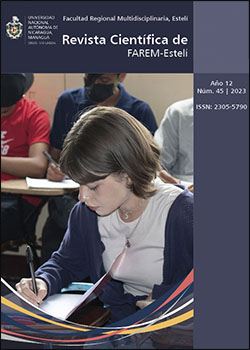Global vulnerability assessment of tailings dams. Moa, Cuba
DOI:
https://doi.org/10.5377/farem.v12i45.16049Keywords:
Tailings dams, risks, climate changeAbstract
Climate change is a risk trigger for tailings dam failures in the mining industry. This factor increases the vulnerability to natural and anthropic dangers of the works, resulting in an increase of environmental incidents of these structures, as they reach greater height, putting at risk the population, the infrastructure and the environment. In this research, an evaluation of the vulnerability of a tailings dam to different hydrometeorological, seismic and technological hazards is carried out, determining through the application of qualitative and quantitative methods the global vulnerability of the work. A zoning is carried out for the evaluation of the danger of natural and anthropic events. The result of the global vulnerability assessment is “very high” in zones B, C and D of the construction site and “high” in zone A. The level of predisposition to damage the structure is “very high”.
Keywords: tailings dams, risks, climate change
Downloads
References
Adiansyah, J. S., Rosano, M., Vink, S. y Keir, G. (2015). A framework for a sustainable approach to mine tailings management: disposal strategies. Journal of Cleaner Production, 108 (Part A, 1), 1050-1062. https://doi.org/10.1016/j.jclepro.2015.07.139
Álvarez. M. J. (2017). Sostenibilidad de tratamientos de residuos mineros asociados al riesgo [Tesis de maestría, Universidad de Oviedo]. Archivo digital. https://digibuo.uniovi.es/dspace/bitstream/handle/10651/43659/TFMMirenJosuAlvarezAmigoRUO.pdf;jsessionid=AC3207AEA3BEED3630537DC314F549F0?sequence=6
Hernández, T. y Guardado, R. M. (2015). Control de erosión mediante bioingeniería en presas de colas de la industria del níquel. Minería y Geología, 30(4), 55-69. http://revista.ismm.edu.cu/index.php/revistamg/article/view/837
Hernández, T. y Ulloa, M. (2014). Impacto ambiental de la ampliación de una presa de colas de la industria cubana del níquel. Minería y Geología, 30(3), 33-48. http://revista.ismm.edu.cu/index.php/revistamg/article/view/Hdez
Hernández. T. (2015). Sistema de gestión de riesgos por fallos de la presa de colas de la empresa Pedro Sotto Alba [Tesis doctoral no publicada, Instituto Superior Minero Metalúrgico de Moa].
International Commission on Large Dams [ICOLD]. (2001, s.f). Bulletin 121: Tailing dams. Risk of dangerous occurrences. Lessons learnt from practical experiences. https://ussdams.wildapricot.org/resources/Documents/ICOLD%202001%20Bulletin%20121.pdf
Martínez, R., Hernández, T. y Chacón, Y. (2017). Método de cálculo de taludes por estados límites. Caso de estudio presa de colas Pedro Sotto Alba. Avances, 19(3), 240-244. http://www.ciget.pinar.cu/ojs/index.php/publicaciones/article/view/275
Oldecop, L., Zabala, F., Rodríguez, R. L. y Garino, L. (2008, 24 de septiembre). Funcionamiento hidráulico, estabilidad y mecanismos de rotura de presas de relaves mineros [conferencia]. V Congreso Argentino de Presas y Aprovechamientos Hidroeléctricos, Tucumán, Argentina. https://www.researchgate.net/publication/242672940_Funcionamiento_hidraulico_estabilidad_y_mecanismos_de_rotura_de_presas_de_relaves_mineros
Wilches-Chaux, G. (1988). La Vulnerabilidad Global. https://www.gub.uy/sistema-nacional-emergencias/sites/sistema-nacional-emergencias/files/documentos/publicaciones/La%2Bvulnerabilidad%2Bsocial%20WILCHES%2BCHAUX.pdf
WISE Uranium Project. (2020, 8 de julio). Chronology of mayor tailings dam failures. https://www.wise-uranium.org/mdaf.html
Published
How to Cite
Issue
Section
License
Copyright (c) 2023 Revista Científica de FAREM-Esteli

This work is licensed under a Creative Commons Attribution-NonCommercial-ShareAlike 4.0 International License.

